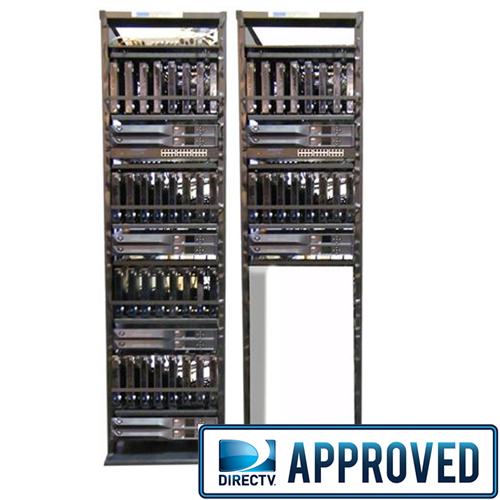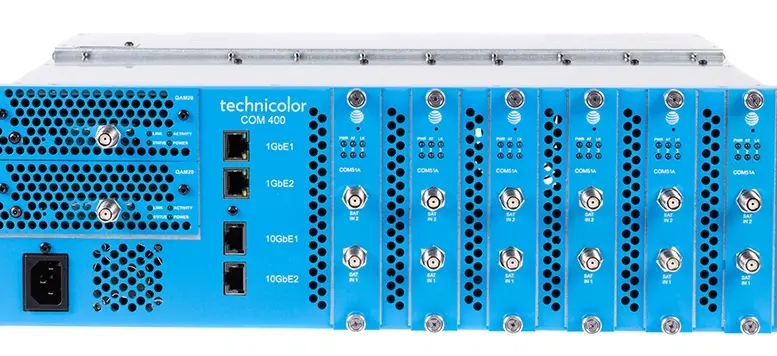I’m a big fan of DIRECTV’s compact headends, going back to the original COM1000 system from over a decade ago. It’s just such a brilliant idea, you have to wonder why no one thought of it before. (Or why most companies still don’t do it…. only DISH’s Smartbox is comparable.) DIRECTV partnered with the company making most of its receivers and challenged them to create as much receiver capacity as possible in the smallest space.
The current generation COM3000 can supply 134 HD channels in a box that’s roughly the same size as two old-school HR34 DVRs. If you’re having trouble imagining the size, it’s smaller than the microwave in your office breakroom. Yet, it’s capable of replacing two full-height racks full of equipment. There’s no secret to how it’s done, not really. The system is just very well designed. It does away with a lot of the extraneous stuff in a receiver like the power supply and outputs, since they aren’t needed. There are also some very well-engineered modulators and encoders which are able to handle the entire data stream in a package about the size of a soda can.
But let’s talk about Pro:Idiom.
DIRECTV’s COM3000 headend uses encryption on the signals it sends down the line. Most other headends don’t. Personally I don’t think that’s a huge deal. It means you can’t buy your TVs from Costco. If you do, you’ll need to outfit them with a separate box to decode the encryption. You’re better off just getting the right TVs in the first place, and Pro:Idiom-equipped TVs aren’t really any more expensive than comparable TVs of the same quality.
DIRECTV requires that Pro:Idiom encryption be used in most COM3000 installs. Note I say “most.” That’s because there are cases where they will let you turn the encryption off. The list of industries that can get waivers changes, so I’ll just suggest that you call us at 888-233-7563 and let us quote it out for you.
But it brings up the question that forms the heart of this article. Why is COM3000 one of the only headend system that requires encryption in the first place? It comes down to the way most headends do what they do.
A typical headend system: not as clean as you’d think
A typical headend system, which looks something like this:

uses racks and racks of receivers. All of them connect to modulators which put them on specific channels. That’s the whole point of a headend. But, they don’t generally connect over HDMI. HDMI has its own encryption that’s designed specifically to keep people from building headends. It’s not impossible to beat with the right “black box,” but it can be problematic to do it that say. As a result, most headends use component inputs instead. This gives a signal that isn’t encrypted. On the other hand, it’s not as clean as a pure digital HDMI signal.
The paranoia of potential piracy
And there’s the big issue. Inside a COM3000 headend, the signals travel around in pure, unencrypted glee. This means anyone with access to them could make unlimited exact digital copies if they wanted. Now, I personally don’t think that there are people scouting around for pure digital signals just so they can make and sell pirate copies. But apparently there are some people at some companies (*cough*Disney*cough*) who think this. They’re terrified of it. And they won’t let a company like DIRECTV build a system that makes it easy.
So how come some industries can use unencrypted COM3000 systems?
It has to do with complex legal dances. I’m not 100% sure how it’s all decided only that there are going to be some cases where the COM3000 system and the signals it puts out don’t constitute a threat to Disney’s profits. Or at least that’s what they’ve been convinced of. Personally I think it’s a little silly given how easy it is at this point to defeat most encryption anyway.
Really the cure for piracy is just giving people a fair price for what they want, but that’s a subject for another article.
Ready to jump into a headend system?
If you’re ready to get serious with your business television needs, call the experts! Signal Connect has been helping customers for over 20 years build the system of their dreams. We’ll take great care of you! Call the experts at 888-233-7563. We’re here during East Coast business hours. If it’s after hours, fill out the form below. We’ll get right back to you!




